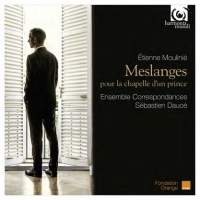Reviewer: Christopher
Price
The music on this disc comes from a collection of sacred music published by
Etienne Moulinié in 1658 with the lengthy title Mélanges de sujets
chrétiens, cantiques, litanies et motets, mis en musique à 2, 3, 4 et 5
parties, avec une basse continue. The book was dedicated to the devout
Marguerite de Lorraine, second wife of Louis XIII's capricious and
rebellious only brother, Gaston d'Orléans, after their forced internal exile
to Blois in 1652 following the collapse of the Fronde uprisings. The Duke,
at once pious and a libertine, seems to have had the knack of engendering
loyalty in his servants despite his difficult character. Moulinié stuck by
him for 30 eventful years.
Moulinié had already completed the book by 1651, when he obtained a royal
privilege to publish it. Over the next seven years, he expended much effort
and expense to print it, even risking bankruptcy in buying special
high‑quality paper, while his printer, Jacques de Sanlecque, cast a special
typeface for the collection. As this disc demonstrates, Moulinié did not
spare any effort in composing the music either.
The disc opens with a motet to the Holy Sacrament, 0 bone Jesu, which
displays in its brief space almost the full range of Mouliné’s musical
skills: it shifts constantly between different combinations of the voices,
from the full ensemble singing homophonically or in harmonically opulent
five‑part counterpoint to one or two voices singing in concertante
style with great melodic freedom. All 14 pieces selected from the collection
for this disc by the director of Ensemble Correspondances, Sébastien Daucé,
share these elements. The constant swell and fall of the music, the
ever‑changing colours of choral passages dissolving into trios, duets and
solos for different voices and then recombining as the full chorus and the
frequent richly ornamented (sometimes air de cour‑like) sallies by
one, two or three voices, are enthralling. Remarkably, these intimate,
reverential works also contain suggestions of the grandiose grand motet
style then being developed in the Royal Chapel.
Interspersed between Moulinié's work is a handful of equally gorgeous choral
and viol consort pieces by other French composers. The most captivating of
these is Antoine Boësset's Jesu nostra redemptio for four
voices, and a consort of two recorders, five viols and organ. This strophic
work, alternating chorus and soloists with instruments alone, is written on
an expansive tune that is almost the French Counter‑Reformation's answer to
the Lutheran chorale.
Before his exile to Blois, Gaston d'Orléans's musical establishment was
relatively modest. Its vocal complement consisted of two boy trebles and
pairs of adult hautes‑contres, hautes-tailles, basses‑tailles and
basses. In Blois, it was reduced further to one voice per part, with a woman
replacing the two trebles even though a significant proportion of the music
was for the liturgy. For certain occasions, additional singers and
instrumentalists were hired in so that, sometimes, Moulinié had a choir of
as many as 20 voices and violins, viols and other instruments supplementing
the household's usual two lutes, bass viol and organ. The extra sopranos on
these occasions appear to have been women. Thus, unusually for modern
performances of Baroque sacred music, the mixed women's and men's voices of
Ensemble Correspondances match almost exactly the forces that Moulinié must
have used in the Duke's chapel after 1652. The exception is the Ensemble's
two female altos, who are listed as bas‑dessus in the booklet but
apparently sing the haute‑contre parts alongside the single
countertenor.
The performances are of breathtaking beauty. As a group, the Ensemble is
lithe and supple, reacting sympathetically to every nuance of Moulinié’s
expressive, text‑driven writing. Individually, its 12 voices are also
remarkably fresh and secure. It is such a pleasure to hear French sopranos
whose voices, while brilliant, favour sweetness over the stridency so common
among their compatriots in Baroque music and who sensitively apply a
tempered vibrato to shape individual phrases or colour individual notes
rather than covering everything with a continuous shake or flutter. The
other voices are equally mellifluous, particularly the high tenors and
baritones (tailles and basses‑tailles). A richly realized
continuo is provided by the bass viol, lute and theorbo as well as Daucé's
harpsichord and organ. The consort of five viols brings an added touch of
suavity to the programme, including in the two Moulinié rnotets performed
purely instrumentally, occasionally joined by the liquid tones of the two
recorders.
The Ensemble's adherence to historical performance practice is even extended
to a seventeenth‑century French pronunciation of the Latin texts. Thus 'c'
tends to be sibilant, 'g' and 'j' are generally soft, 'u' sounds the same as
in 'mute' and, a new one for me, 'alleluia' is pronounced 'alle‑LWEE‑ah' to
match the French pronunciation of the diphthong 'ui'; all of which can be
heard very clearly thank's to the impressively transparent sound
engineering.,
In short, this disc presents a
perfect marriage of sublime music and outstanding musicianship.
Fermer la fenêtre/Close window
|
 " ... this disc presents a
perfect marriage of sublime music and outstanding musicianship".
" ... this disc presents a
perfect marriage of sublime music and outstanding musicianship".



